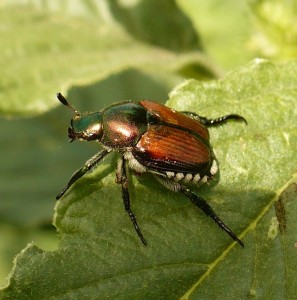The Japanese beetle (Popillia Japonica) can be a significant economic pest in Northeastern hop yards. Japanese beetles begin to show up in Vermont at the very end of June or early July, and are most active on warm, sunny days. We spotted a Japanese beetle in our hop yard at Borderview Farm on July 1. Japanese beetles can be found feeding on the fruits, flowers, and foliage of over 200 plants. Hop leaves damaged by Japanese beetles are skeletonized, with only the veins left behind. The adult is an oval-shaped beetle with a metallic green body, copper-colored elytra (hard front wings) and tufts of white hair along its abdomen. Japanese beetles overwinter in the soil as white C-shaped grubs, where they feed on the roots of many crops, though they are not known to cause significant damage to hops as grubs.

Read the full fact sheet on Japanese beetles on our web site – https://www.uvm.edu/sites/default/files/media/Japanese_beetle_in_hops.pdf
There are several conventional and OMRI approved chemicals that can be used to manage Japanese beetle adults in Northeastern hop yards. See Table 1 in our factsheet for a list of approved insecticides for Japanese beetles on hops in MA, NY and VT for 2012. This list is not exhaustive; please check with your local Extension service or Agency of Agriculture. When using a pesticide, be sure to read the label in its entirety. It is illegal to use a chemical in a site or on a pest for which it is not specifically labeled. Be sure to adhere to pre-harvest intervals and use proper personal protection equipment. It is always advisable to try out a new pesticide or tank mix on a few plants to evaluate a crop’s reaction before spraying the whole yard. Also note that there are some varietal differences in reactions to certain pesticides.
Most insecticides will not only kill target pests, but can also be damaging to beneficial insect populations. When applying an insecticide in your hop yard, always be aware that eliminating beneficial insects can lead to secondary outbreaks, when a less abundant pest is given an advantage by removing its natural enemies. The hop burr is very susceptible to mechanical damage during pesticide applications, so if at all possible, try to avoid spraying during burr development. Instead, spray just prior to flowering and use a product that is a very effective protectant with a long residual period.
In addition to chemical controls, biological control of Japanese beetle grubs can be very effective. There are several beneficial nematodes, which are commercially available, and applied as a soil drench. Another effective biological control of Japanese beetle grubs is the milky spore bacterium (Bacilluspapillae), which comes in the form of a powder that can be applied to the soil.